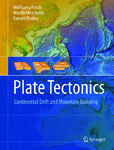| dc.description.abstract | In the late 1960’s, Wegener’s theory of continental
drift , originally conceived fi ft y years earlier, was
merged with the theory of plate tectonics and the
concepts gained global acceptance among geoscientists.
For the fi rst time, a unifying concept, plate
tectonics, could reconcile and unify all phenomena
in geoscience into a common synthesis. Th e basic
tenants have not changed since the 1960’s, although
many corrections and refi nements have been added
regarding questions of detail. Th e impact of the
theory of plate tectonics cannot be overestimated –
its importance to geoscience is as basic as Darwin’s
theory of evolution is to the biological sciences.
Earth is subject to steady change. Th is can impressively
be realized in volcanic bursts and earthquakes
around the Pacifi c Ocean or in the grandeur of
young mountain ranges. Whilst new parts of plates
are created along the mid-ocean ridges, older parts
of plates disappear in subduction zones. Mountain
chains arise from the collisions of plates. Th ese dynamic
processes are driven by the heat that is released
from the interior of the Earth; this is what keeps the
dynamo running. Continental drift , mountain building,
volcanism, earthquakes, and in consequence of
quakes, sea waves like the devastating tsunami of
26th December 2004 in the Indian Ocean – all this
is the expression of the dynamics of the Earth.
Th is book presents an introduction in the wide
fi eld of plate tectonics and is dedicated to a broad
audience interested in natural sciences, and students
and professionals in geosciences and related subjects.
Expertise in tectonics is not a pre-condition; the technical
terms and geological processes are explained
and reviewed in adequate detail. Many terms are
defi ned in the glossary at the end of the book and a
keyword index enables quick location of topics and
terms in the text. Figures at the inside front-end
and back-end covers present concise overviews of
the geologic timescale and critical events in Earth
history as well as the classifi cation of magmatic and
metamorphic rocks. More than 200 references enable
the studious reader to gain deeper insight into
special topics. | en_US |

